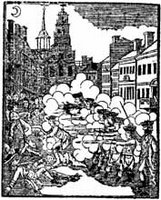Robert Patterson: disabled sailor
 As he testified in March 1770, Robert Patterson was wounded in the right arm during the Boston Massacre—one of several Bostonians injured in that shooting on top of the five killed. Patterson evidently suffered such damage that he became unable to do the physically demanding work of a sailor.
As he testified in March 1770, Robert Patterson was wounded in the right arm during the Boston Massacre—one of several Bostonians injured in that shooting on top of the five killed. Patterson evidently suffered such damage that he became unable to do the physically demanding work of a sailor.
On 30 Jan 1771, selectmen John Hancock and Jonathan Mason and Overseer of the Poor Royall Tyler signed the paperwork to allow Patterson to stay in the Boston workhouse. The Boston town records say:
Mr. Paul Farmer Keeper of the Alms house was directed to receive into the Alms house to be supported at the Province Charge one Robert Patterson a Stranger and not an Inhabitant of any Town in this Province, being Poor & having lost the use of his Right Arm on the 5 of March last in the Massacre made by the Soldiers.It’s not clear how long Patterson remained there.
As I recounted last week, starting in 1774 young Christopher Monk was the beneficiary of donations collected at the oration Boston commissioned on each anniversary of the Massacre. In 1781, after Monk died, Patterson evidently feared all that charitable instinct would go to waste, so he asked if he could start receiving the donations instead. The town records for 5 Mar 1781 say:
a Petition of Mr. Robert Patterson setting forth, “that he received a wound in his Right Arm on the 5th. of March 1770. by a Shot from [Capt. Thomas] Prestons Party, whereby he has entirely lost the use of it; and that since the death of Mr. Monk he is the only one of the unhappy number then badly wounded, that survive,” and therefore praying the Charity of the Town—was read, whereuponAnd the blank was never filled in. Instead, two days later selectman John Scollay told his colleagues:
Voted, that a Collection be made at the close of this Meeting, for the said unhappy Sufferer, and Boxes were placed at each Door to receive the Collections
The Collection made for the said Mr. Patterson, amounted to the Sum of
that the Money Collected for Mr. Patterson at the Town Meeting the 5th. of March in consideration of the wounds he received the 5 of March 1770 from Prestons Party, amounted to £326’15’4. Old Money & 4/ & 1/2 hard Money—Bostonians seem to have been clearing out their old, devalued paper currency but parting with few hard coins. Patterson presented the same petition in January 1782, and the town meeting again approved it. That March, the selectmen’s minutes recorded:
Mr. Scollay was desired to retain the Money belonging to Mr. Patterson, till further enquiry can be made respecting him which was accordingly done
There was Collected for James Patterson, who was wounded the 5 of March 1770, the Sum of Seven Pounds twelve Shillings,—and the same has been put into the hands of Capt. William Mackay, for the use of the said Patterson, & his WifeNearly £8! Obviously, Patterson’s public image wasn’t as heart-tugging as Monk’s had been. And town clerk William Cooper even got his name wrong.
In 1783, Patterson’s cause suffered further. First, another surviving Massacre victim turned up, asking for cash. The town records say:
A Petition of John Green one of the Persons wounded on the Evening of the 5th. of March 1770 also the request of Mr. Patterson who lost the use of one of his Arms on that, memorable Night—was read—and considered—John Green’s name didn’t appear on the first published list of Massacre victims, but the Boston Gazette that followed named him and said he was a tailor. (A young man named John Green had run to fetch soldiers when a crowd threatened the sentry outside the Customs house, but I doubt this was the same man who was shot since that would have been too ironic not to be mentioned somewhere.)
A Collection was made for the aforenamed Persons amounting to the Sum of and put into the hands of the Selectmen to be distributed as they may Judge proper
In 1783, Green and Patterson probably split the few pounds collected, their last chance to do so. It was already clear that the war was coming to a close, and the Massacre remembrances no longer had propaganda value. Boston voted to shift its annual oration to Independence Day. I don’t know what happened to Robert Patterson after that.

4 comments:
Is there any evidence as to which ship Patterson sailed on?
The one clue I’ve found is that Patterson was at Capt. Hector MacNeill’s house when he heard the alarm that preceded the Massacre.
It’s possible he was there as part of a social gathering or as a boarder, or that might be a hint that Capt. MacNeill was his regular employer.
MacNeill was a Scotch-Irish immigrant who captained American ships during the Revolution. He left a memoir, but it covers his early life and career only.
Thanks! I think I'll look up that memoir...Any suggestions on where to find it?
Click the link on his name.
Post a Comment